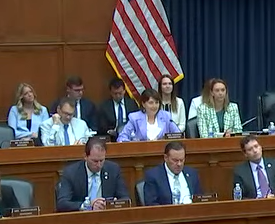LAS VEGAS — With the NAB’s efforts to preserve AM radio access in every U.S. vehicle getting strong applause on Tuesday during association head Curtis LeGeyt‘s welcome remarks at the 2024 NAB Show, there’s a strong sense that Congress is oh-so-close to passing the AM Radio for Every Vehicle Act.
On Wednesday, the head of the House Energy and Commerce Committee and its Democratic Ranking Member shared plans for an April 30 legislative hearing that could push the effort forward in a big way.
House Energy and Commerce Committee Chair Cathy McMorris Rodgers (R-Wash.) and Ranking Member Frank Pallone Jr. (D-N.J.) will convene a session on April 30 entitled “Draft Legislation to Preserve Americans’ Access to AM Radio.”
In a brief statement released just before 9am Pacific, Pallone and Rodgers stated, “Communities across the country, especially rural communities, rely on AM radio service for critical information. It plays an essential role during public emergencies when other alert systems that rely on the electric grid and cellphone networks don’t work, which is why it’s so alarming that some auto manufacturers are considering not installing AM radios in new cars. We look forward to working together to preserve Americans’ access to this vital source of information.”
The legislative hearing will be formally held by the House E&C Subcommittee on Innovation, Data, and Commerce. And, it will focus on H.R. 3413, which as of today has a stunning 244 co-sponsors — the highest number of any piece of Congressional legislation to involve Radio in years.
The AM Radio for Every Vehicle Act would require the Department of Transportation (DOT) to issue a rule that requires all new motor vehicles to have devices that can access AM broadcast stations installed as standard equipment.
As AM broadcast stations are often used to deliver emergency alerts and news and entertainment programming, and some newer vehicles do not include AM equipment, there is widespread agreement that not having kHz-based radio reception in a vehicle would pose a threat to drivers.
Specifically, this bill applies to motor vehicles manufactured in the United States, imported into the United States, or shipped in interstate commerce after the rule’s effective date. The DOT rule would require all such vehicles to have devices that can receive signals and play content transmitted by AM broadcast stations or digital audio AM broadcast stations installed as standard equipment. Prior to the effective date of the rule, manufacturers that do not include devices that can access AM broadcast stations as standard equipment must inform purchasers of this fact through clear and conspicuous labeling.
What if an automotive company does not comply? The DOT may assess civil penalties against any manufacturer that fails to comply with the mandate. The Department of Justice may also bring a civil action to enjoin a violation.
Further, the Government Accountability Office would be tasked to study and report on whether a reliable alternative communication system exists for delivering emergency alerts and consider the cost to drivers and passengers of receiving communications through an alternative system, and cost and time required to develop and implement an alternative.
News of the hearing on April 30 comes as AM radio received a strong ovation during NAB CEO Curtis LeGeyt’s “fireside chat” during the NAB Show welcome session.
On Tuesday, LeGeyt responded to the hearing news by commenting, “NAB is deeply grateful to Chairwoman Cathy McMorris Rodgers and Ranking Member Frank Pallone for their continued leadership in safeguarding continued access to AM radio in new cars. With 82 million monthly listeners, AM radio is the backbone of the Emergency Alert System and serves as a trusted source of factual news and diverse programming in communities across the country. Local broadcasters look forward to continue working with Chairwoman McMorris Rodgers, Ranking Member Pallone and all committee members to ensure this critical communications medium remains accessible to listeners across the country.”





